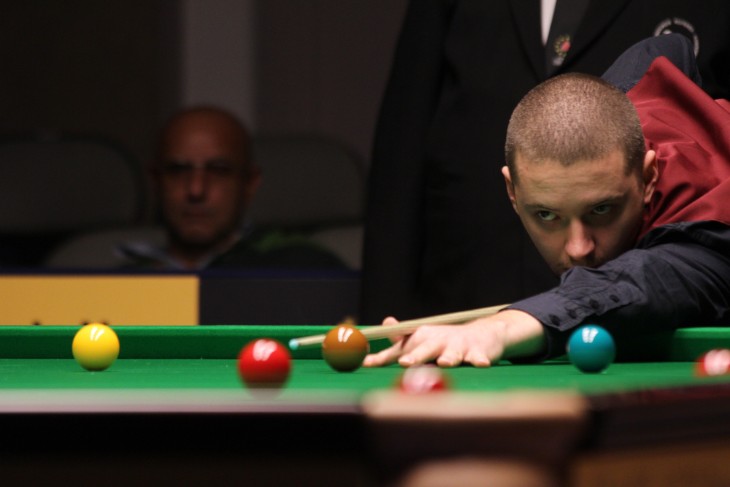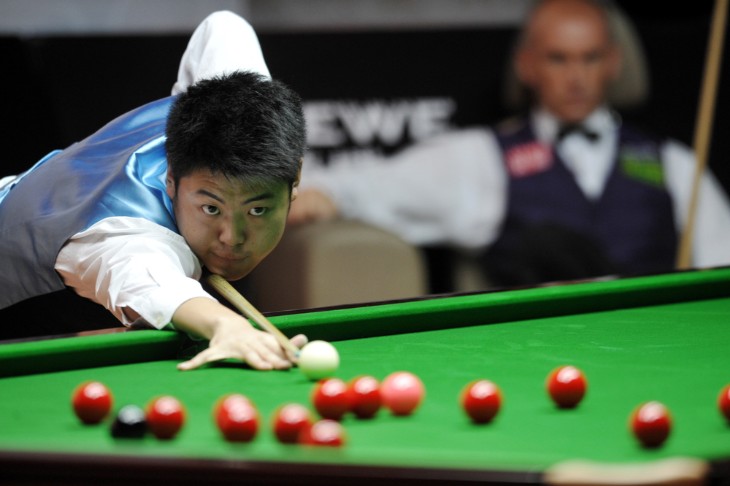- Understanding Total Frames (Adjusted) Betting: A Comprehensive Overview
- Key Factors Influencing Total Frames in Snooker Matches
- The Role of Player Form and Historical Performance
- Psychological Factors and Match Pressure: Their Impact on Frame Count
- Strategies for Successful Total Frames (Adjusted) Betting
- Leveraging Statistical Tools and Data in Total Frames Betting
- Navigating the Challenges and Excitement of Total Frames Betting
- Final Takeaway
In the world of snooker betting, 'Total Frames (Adjusted)' stands out as a unique and strategic choice. This form of betting isn't just about who wins or loses; it's about predicting the total number of frames in a match, adjusted for various factors. It requires a deep understanding of the game, the players, and the subtleties that influence a match's length.
For those looking to dive into this sophisticated betting option, this article offers insights into mastering the art of Total Frames (Adjusted) betting.
Understanding Total Frames (Adjusted) Betting: A Comprehensive Overview
Total Frames (Adjusted) betting in snooker is a bit different from other types of betting. Instead of just picking who will win, you try to predict the total number of frames in a match. But it's not just a simple count. This type of betting takes into account various adjustments based on different factors. These factors can include how well the players are currently playing, their history in similar matches, and even the type of tournament they're in.
The idea behind this betting is to make a more accurate guess about how long a match will last. For example, if two top players are competing, you might expect more frames because they are evenly matched. But if one player is much better than the other, the match might have fewer frames. The adjustments are there to take these differences into account.
In Total Frames (Adjusted) betting, you have to think about more than just who is the better player. You need to consider how they play against each other. Some players might play faster or more aggressively, which can lead to shorter matches. Others might be more defensive, which can mean longer matches with more frames.
You also need to think about the players' current form. If a player has been winning a lot recently, they might be more likely to win frames quickly. But if they've been struggling, the match might be closer and last longer.
Total Frames (Adjusted) betting is about predicting the length of a snooker match. It's not easy, because you have to consider many different factors. But if you understand the players and the game, it can be a really interesting way to bet on snooker.
Key Factors Influencing Total Frames in Snooker Matches
- Player Skill Levels: The skill levels of the players in a snooker match are a big factor. When two top players face each other, the match often has more frames. This is because they are evenly matched, and neither gives up easily. But if one player is much better than the other, the match might end quickly with fewer frames. Knowing the players' skills helps you predict the length of the match.
- Playing Styles: How players approach the game also affects the number of frames. Some players are aggressive and try to finish frames quickly. Others play more defensively, leading to longer frames. If both players are defensive, you can expect a match with more frames. But if one is aggressive and the other isn't, the match might be shorter.
- Match Importance: The importance of the match can change how players play. In big tournaments or crucial matches, players might be more careful. This can lead to longer frames as they try to avoid mistakes. In less important matches, players might take more risks, leading to shorter frames.
- Player Form: A player's current form is key. If a player has been winning a lot, they might be more confident. This can lead to them playing better and winning frames more quickly. But if a player isn't in good form, they might struggle, leading to longer frames as they fight to stay in the match.
- Head-to-Head History: Finally, the history between the players matters. If they have played many times before, their past matches can give you clues. Some players might always have close matches with lots of frames, while others might usually have shorter matches. Looking at their previous encounters can help you guess how many frames their next match might have.

The Role of Player Form and Historical Performance
In Total Frames (Adjusted) betting, the form and past performance of players are crucial. How a player has been performing recently can tell you a lot about how they might play in an upcoming match. For example, if a player has been winning a lot and feels confident, they're more likely to play well and win frames quickly. This can lead to fewer total frames in the match.
Historical performance is also important. This means looking at how players have done in past matches, especially against similar opponents. Some players might have a history of playing long matches, while others tend to play shorter ones. By looking at their past games, you can get a good idea of how many frames they might play in their next match.
It's not just about wins and losses. You should also look at how players have won or lost their frames. A player might lose a match but still play well, which could mean they're in good form. On the other hand, a player might win a match but struggle to win frames, which could be a sign they're not playing their best.
In summary, when you're betting on Total Frames (Adjusted), think about how the players have been performing recently and in the past. Look at their recent wins and losses, and how they've played in those matches. This can give you good clues about how they might perform in their next match and how many frames the match might have.
Psychological Factors and Match Pressure: Their Impact on Frame Count
- Players' Mental Toughness: A player's mental toughness can greatly influence the number of frames in a match. Players who are mentally strong tend to handle pressure better. They stay focused and make fewer mistakes, which can lead to winning frames more efficiently. On the other hand, players who get easily stressed may lose focus, leading to longer frames as they struggle to maintain their game.
- Effect of High-Stakes Matches: In high-stakes matches, such as tournament finals, the pressure is much higher. This can affect players differently. Some thrive under pressure and play their best snooker, potentially reducing the number of frames. Others might feel the weight of the moment, leading to more cautious play and longer frames as they try to avoid costly mistakes.
- Response to Audience and Atmosphere: The presence of an audience and the overall atmosphere can also impact frame count. A supportive crowd can boost a player's confidence, helping them play better and win frames quickly. In contrast, a hostile or noisy crowd can increase a player’s nerves, potentially leading to longer frames due to cautious play.
- Handling Previous Mistakes: How players react to their own mistakes can influence the match’s length. Players who can quickly move on from a bad shot or a lost frame are less likely to let one mistake lead to another. This can result in them maintaining control and finishing frames efficiently. Conversely, players who dwell on their errors may lose rhythm, leading to longer frames as they struggle to regain composure.
Strategies for Successful Total Frames (Adjusted) Betting
- In-Depth Player Analysis: The first step to successful betting in Total Frames (Adjusted) is to thoroughly analyze the players. Look at their recent performance, style of play, and head-to-head history. A player who has been in top form is likely to win frames more efficiently, suggesting a potentially lower frame count. Understanding each player's approach to the game, whether aggressive or defensive, also helps in predicting the pace and length of the match.
- Consideration of Match Context: The context of the match plays a crucial role. For high-stakes games or crucial tournament stages, players often adopt a cautious approach, leading to longer, more strategic frames. Conversely, in less significant matches, players might play more freely and aggressively, possibly reducing the number of frames. Assessing the importance of the match to each player can provide valuable insights into their likely approach.
- Monitoring Table Conditions and Venue: The condition of the snooker table and the venue atmosphere can impact the game's flow. Faster tables can lead to quicker frames, while slower tables might prolong the game. Similarly, a familiar and comfortable venue might boost a player's confidence, affecting the frame count. Keeping an eye on these factors can aid in making more accurate predictions.
- Utilizing Statistical Data and Trends: Leveraging statistical data and past trends is vital. Look at the average frame counts in players' previous matches and any notable trends in their performances. Tools and apps that offer statistical insights into players' average frame lengths in various conditions can be extremely helpful in making informed betting decisions.

Leveraging Statistical Tools and Data in Total Frames Betting
- Using Historical Data for Predictions: One effective way to bet on Total Frames (Adjusted) is to use historical data. This involves looking at past matches and analyzing the average number of frames in games involving the current players. Historical data can reveal patterns, like whether a player tends to be involved in longer or shorter matches. This information is invaluable in making more accurate predictions about the total number of frames.
- Accessing Real-Time Statistics: Real-time statistics provided by various online platforms can be a game-changer. These tools offer up-to-the-minute data on ongoing matches, which is crucial for live betting. They provide insights like the current form of the players, how they're performing on the day, and whether they're playing more aggressively or defensively than usual. This information can help adjust your betting strategy as the match progresses.
- Utilizing Frame Average Calculators: Some websites and apps offer tools that calculate players’ average frame counts. These calculators take into account various factors, such as recent performance, head-to-head records, and playing styles. By inputting the relevant data, you can get an estimated number of frames for a particular match, which can guide your betting decisions.
- Analyzing Player Stamina and Endurance: For longer tournaments, considering players' stamina and endurance can be crucial. Statistical data can show how players perform in longer matches or towards the end of tournaments. Players who maintain their performance levels over longer periods are less likely to see an increase in frames as a result of fatigue. This aspect can be a key determinant in predicting total frames in later stages of a tournament.
Navigating the Challenges and Excitement of Total Frames Betting
- Embracing the Unpredictability: One of the biggest challenges in Total Frames betting is the unpredictability of snooker matches. Unlike other sports, snooker can have sudden shifts in momentum, making it hard to predict the total number of frames. This unpredictability adds excitement to betting, as each match can unfold in unexpected ways. Bettors need to embrace this uncertainty and use it to their advantage by staying alert to the game's dynamics.
- Making Informed Decisions: Another challenge is the need for making informed decisions. Total Frames betting requires a deep understanding of both the game and the players. This means keeping up-to-date with players’ forms, their styles, and even psychological factors that could influence the match. Successful betting involves continual learning and adapting strategies based on the latest information.
- Handling the Pressure of Live Betting: Total Frames betting can be particularly intense during live betting. Here, bettors need to make quick decisions based on the ongoing match. This requires not only a good understanding of the game but also the ability to stay calm under pressure. The thrill of making real-time decisions adds to the excitement of Total Frames betting, offering a dynamic and engaging experience.
- Balancing Risk and Reward: Finally, there's the challenge of balancing risk and reward. Total Frames betting can sometimes involve taking risks, especially when betting on unexpected outcomes. The key is to find a balance - using statistical analysis and intuition to make bets that have a higher probability of success, while also being prepared for any outcome. This balance between risk and reward is what makes Total Frames betting both challenging and exhilarating for bettors.
Final Takeaway
In conclusion, Total Frames (Adjusted) betting in snooker offers a rich and complex avenue for betting enthusiasts. It demands not just knowledge of the game but also an ability to analyse various influencing factors. By embracing the challenges and intricacies of this betting type, bettors can enhance their engagement with the sport and potentially find success in this sophisticated betting arena.




.webp)


 (1).webp)




















